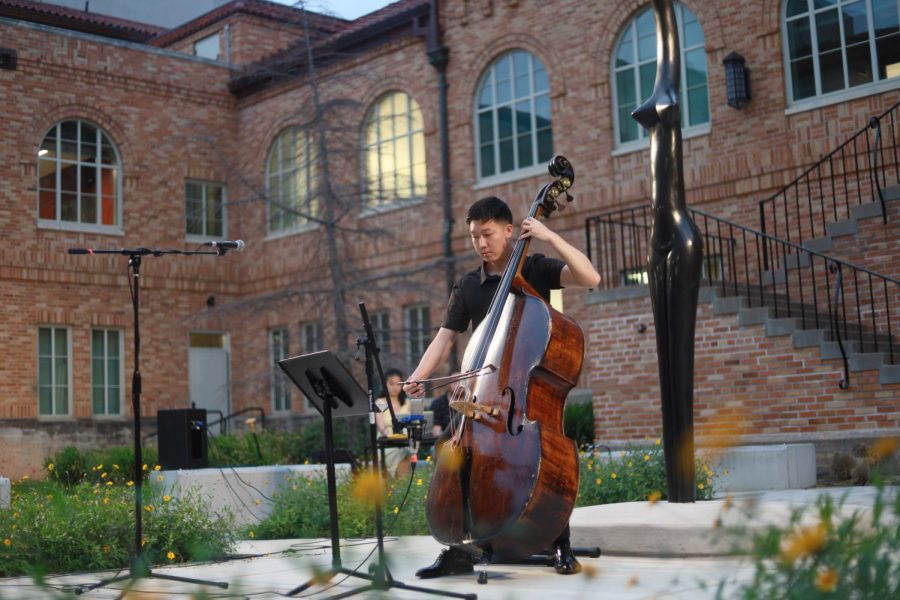Sound in Sculpture’s Eighth Annual performance moves audience with music and physical art
April 25, 2022
The composer gave a slight nod, and the Anna Hiss Gymnasium Courtyard flooded with choral voices and string instruments. Singers took turns performing in different languages, and a string solo played rhythmic sequences in front of “Sentinel IV,” a sculpture of a giant spoon.
For this year’s Sound in Sculpture, the Butler School of Music, UT Landmarks and Texas Performing Arts came together to present their eighth annual immersive showcase on April 21. After weeks of composition and rehearsals, Butler School of Music students performed original music inspired by UT’s public art collection. The concert kept the audience on their feet, moving from sculpture to sculpture.
The event included “Sentinel IV” and “EON,” a digital art piece that depicts biomorphic shapes and images flowing through water in the Welch Hall. The moving musical troupe of 13 included vocalists, strings and electric pianists.
Ginny Wang, Sound in Sculpture composer and composition graduate student, said composing original music to speak for a sculpture became a way to blend history with two forms of art. Utilizing both material and musical forms, Wang said the event truly immerses the audience in the performance.
“I am representing this piece of artwork and showing my piece of music, so people can visualize these at the same time,” Wang said. “It (brings) much deeper information about what this artwork mastered.”
Music performance freshman Gabreauna Nash, one of Sound and Sculpture’s four singers, said when she performed in front of “Sentinel IV,” a statue of a Zulu ceremonial spoon, she had the opportunity to express her admiration for heritage and bring awareness to the history and resilience of Black women in art.
“I’ve never done anything like that in my life,” Nash said. “It was great to be singing about something that has to do with my heritage. It meant something to sing about this artwork because it’s the only sculpture by an African American artist on campus. That was really important.”
Kevin Charoensri, a Sound in Sculpture composer and music composition freshman, said the freedom UT Landmarks and the Buttler school offered composers and artists gave them the liberty to experiment. Charoensri said he pushed his composition skills and fostered an intimate connection with the artist of the sculpture.
“Usually, you have some sort of instrumentation you’re boxed into,” Charoensri said. “I took away this idea of the symbiosis that the artist of EON was inspired by, and I took (this) aspect of really working together and understanding what the artist was trying to say.”
Nash said delving into each piece’s history and significance encapsulates the true meaning of Sound in Sculpture. Adding to not only her personal experience but the collective experience, Nash said performing in a space that connects the audience to the environment can make for a supportive place of inclusivity and understanding.
“The unique aspect of the concert is that all the places (are) on campus,” Nash said. “It gave me and the audience a way to explore the community aspect. People come out to not just listen to a concert but are supporting the message of the artists as well, which is the most important part.”



